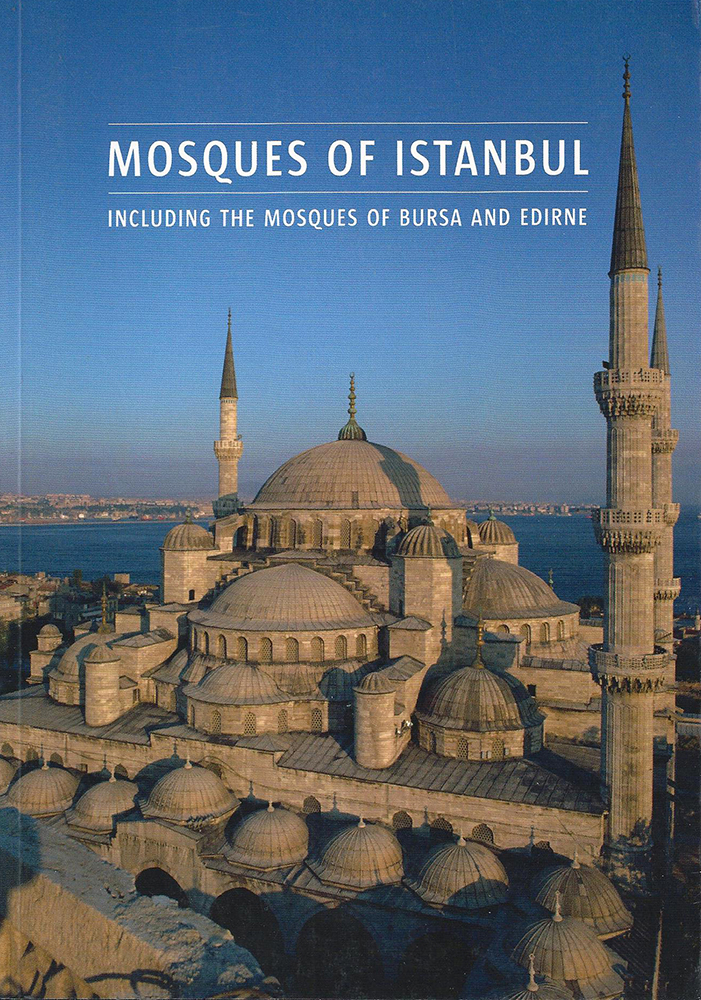
Scala Publishers, London and Istanbul 2010
ISBN 978-1-85759-307-5
Content
160 Pages. 115 color photos, 28 drawings,8 maps, Chronological table, Glossary
Buying the book:
- Available in bookstores and on the internet.
- Directly from this website. Price $30 including postage. Only to addresses in the USA. Use Paypal button below
The author, Henry Matthews, conceived this book both as a guide for travelers and an introduction to Ottoman mosques for readers interested in architectural history. In a chronologically planned account, he traces their evolution from small, fourteenth century examples in the first Ottoman capitals, Bursa and Edirne, to those built after the capture of Constantinople in 1453 and goes up to the nineteenth century. The centerpiece of the book is an analysis of the work of Michelangelo’s contemporary, the great sixteenth century architect Mimar Sinan who experimented boldly with structure, space and light. His work ranges from small neighbourhood mosques with charming gardens to the the vast centralized structures commissioned by Suleyman the Magnificent and his son Selim II. The story continues with the fascinating innovations of the late classical, Baroque and neoclassical periods.
The author places these buildings in their social, historical, and religious context and shows how they were set in complexes of social and educational buildings forming the nuclei of neighborhoods. He also offers an insight into Ottoman life and the patronage of the sultans and viziers as well as powerful women of the court. Short features are included on the history and principles of Islam, calligraphy, and ceramic tiles. With 115 full colour illustrations and a lively, informative text, Mosques of Istanbul is indispensable both to the visitor and to those wishing to understand Ottoman architecture. The buildings are explained and analyzed with the help of fine photography and clear architectural drawings.
The book concludes with maps and itineraries in Istanbul, Bursa and Edirne that lead visitors through carefully planned sequences of mosques by easy and convenient routes. The main map of Istanbul color codes the mosques by historic period. For the convenience of travelers it also includes other historic sites. It is supplemented by detailed maps for thematically organized itineraries. To help readers to understand the complexities of Ottoman history, a chronological table is conveniently placed on the front and back end papers. It is arranged in four columns with the sultans, the mosques, historical events and world architecture juxtaposed for easy reference. There is also a glossary of English architectural terms and one of Arabic and Turkish terms.
Reviews
Meet the mosques
This new guide to the Islamic architecture of Istanbul neatly fills a gap in the literature on the subject, and will slip comfortably into the interested tourist’s day bag as well.
Until now, if you were serious about touring the city’s Ottoman mosques and getting beyond the briefest of info provided on site, or the dubious apocryphal stories of local guides, you needed to take Gülru Necipoğlu’s heavyweight ‘The Age of Sinan’ with you, and that only covered the classical period.
Henry Mathews literally takes the reader on a tour of the city’s major Islamic monuments, explaining the historical and personal contexts behind the design of each and providing tasteful explanation of what makes them work the way they do. The onus is on the sense of space and personality of each building, making for a more accessible read than many of the more scholarly publications on the subject. Indeed, the slightly unwieldy title gives a good indication of its intended audience. “Mosques of Istanbul, including the mosques of Bursa and Edirne,” could conceivably be replaced with “Mosques of the Ottoman capitals” for a more initiated readership.
The mosques are broken down into sensible categories – pre-conquest, converted churches, classical period, late classical, baroque, and late nineteenth-century – by which they are also grouped on the accompanying map.
Thankfully, the walking itineraries take the practicalities of exploring modern Istanbul into account and are arranged mostly by geography rather than style or period, though history dictates that there is a connection. They will sometimes lead the reader to some less than idyllic thoroughfares, however, so be prepared to be a little creative in your wanderings if you want to keep the sense of serenity such sites induce intact along the way.
Michael Hornsby in Cornucopia, Istanbul 2011
“Mosques of Istanbul”, an illuminating new guide book for Istanbul
Matthews has a distinguished career as an architectural historian. He has published books and articles on various aspects of architectural history. Perhaps most importantly, as the short biography of the author in the inside of the front cover points out: “His greatest interest is in making the history of architecture accessible to students and general readers. He hopes with this book to bring an understanding of Ottoman architecture to a wider public.
As part of that hope, Matthews has included a section on the rise of Islam and explains in separate articles various aspects of the mosque, from visitor etiquette to the background behind the beautiful İznik tiles that decorate some of the mosques. Inside the front and back covers is a chronological table so that one cannot lose their way in terms of the time frame.
Niki Gamm, Hürriyet Daily News Istanbul, January 30, 2011
“This is a book that will reach a wide audience interested in Islamic architecture and culture in general and those curious about the architectural heritage of Turkey in particular. It will be read by scholars and adventurous travellers, filling a gap in the body of work available on the subject”
Rafi Samizay The Art Book November 2010
